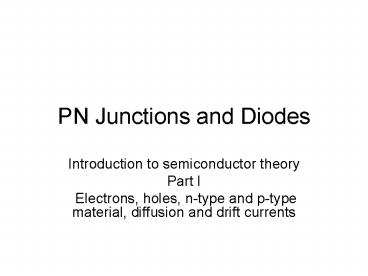PN Junctions and Diodes - PowerPoint PPT Presentation
1 / 22
Title:
PN Junctions and Diodes
Description:
Silicon atom has four valent electrons. Each atom thus forms co-valent bonding with four neighboring Si. ... Drift Current: motion due to an applied electric field. ... – PowerPoint PPT presentation
Number of Views:76
Avg rating:3.0/5.0
Title: PN Junctions and Diodes
1
PN Junctions and Diodes
- Introduction to semiconductor theory
- Part I
- Electrons, holes, n-type and p-type material,
diffusion and drift currents
2
Intrinsic Silicon
The following simplified 2D figure illustrates
the crystal structure of Silicon (Si) (in reality
all connections are in 3D space)
3
Electron-Hole Pairs
Silicon atom has four valent electrons. Each atom
thus forms co-valent bonding with four
neighboring Si . Due to random thermal energy,
some of these bondings may break down, releasing
free electrons into the crystal lattice. A space
vacated by the electron is a hole.
4
Electron and Hole Concentrations in Pure Silicon
concentration of free electrons of free
electrons / 1 cm3
concentration of holes of holes / 1 cm3
stands for intrinsic (pure).
5
Formula for ni
The intrinsic concentration is a strong function
of the temperature. A well known semi-conductor
physics theoretical relationship is
where B material-dependent coefficient
5.41031 for Si EG bandgap energy 1.2 eV
for Si K Boltzmanns constant 8.6210-5
eV/0K T temperature 0K
6
Numerical Example (ni)
At room temperature ( T 3000K ), a direct
substitution of T into the above formula yields
1.51010 carriers/cm3.This may look like a
large number but keep in mind Avogadros number
there are about 51022 atoms/cm3. In other words,
at room temperature only one of every billion
atoms of Si becomes ionized (by losing an
electron, due to thermal energy).Intrinsic
Silicon is not such a great conductor, and it is
pretty useless in its pure form.
7
Doped Silicon (n type)
Free electrons are added, without adding any
holes. Typical donor concentration values ND
donor concentration 1017 donors/cm3
8
Doped Silicon (p type)
Adding free holes, without adding free
electrons. Typical acceptor concentration
values NA acceptor concentration 1016
donors/cm3.
9
Important property of semiconductors
For intrinsic Silicon we have
It turns out that for doped Silicon we also have
That is, for any concentration levels n and p,
the product np is constant that depends on the
temperature T.
10
For n-type Silicon
Let n be the majority free electrons
concentration in the n-type material, ND be the
concentration of doped electrons and n0 be the
concentration of Si free electrons. Then
because ND gtgt n0 Note that ND is independent of
T!
pn,0 is the minority holes concentration in the
n-type material. It does depend on T.
11
Holes Concentration in n-type Si (example)
Let ni 1.51010 carriers/cm3 and ND 1017
electrons/cm3, then
holes/cm3, a small number indeed.
12
For p-type Silicon
Let p be the majority free holes concentration in
the p-type material, NA be the concentration of
doped holes and p0 be the concentration of Si
free holes. Then
because NA gtgt p0 Note that NA is independent of
T.
np,0 is the minority electrons concentration in
the p-type material. It does depend on T.
13
It is still Silicon
In a conclusion, keep in mind that by adding
doped atoms to the Silicon material we do not
change the basic nature of the material it is
still Silicon. We just dramatically change the
material electrical conductivity.
14
Two types of currents
- Current is created due to motion of electrons and
holes. - Diffusion Current Random motion due to thermal
and concentration-difference effects. - Drift Current motion due to an applied electric
field.
15
JCurrent Density A/cm2current per unit area
of a plane perpendicular to the x-axis
16
Holes Diffusion Current Density
JP -qDPdp/dx DP diffusion coeficient of
holes Typical value DP12 cm2/s q1.610-19Cb
17
Holes Diffusion Current Density sign explained
JP -qDPdp/dx Since dp/dxlt0 in the
x-direction Then JP is positive in the
x-direction
18
Electrons Diffusion Current Illustration
19
Illustration of Drift Current
- Vdrift,Paverage velocity of holesµPE
- µP mobility of holes480 cm2/Vs
- Vdrift,Naverage velocity of electrons -µNE
- µN mobility of electrons1350 cm2/Vs
20
Drift hole and electron currents both contribute
to the total current
21
Drift Current Formula
- Holes drift currentiP( charges in a volume of
Adx)/(time that charges travel dx)(qp)(Adx)/(dx
/vP)qpµPEA - Holes current density JPiP/AqpµPE
- Total current density due to drift
- Jdriftq(pµPnµN)E (Ohms Law)
- Note that q(pµPnµN) is the conductivity of the
material.
22
Interesting connection between diffusion and
drift currents
- Einsteins relationship
VT is the diodes thermal voltage (25.2mV at
T200C































